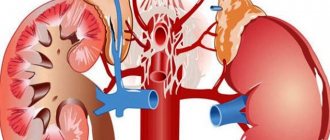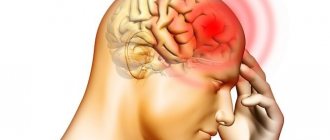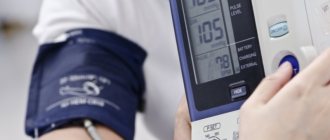Changes with high blood pressure
For a person far from medicine, high blood pressure only means indicators exceeding 120x80. In fact, for the body, a change in indicators in a larger direction threatens with serious consequences. Hypertension has a very selective effect on vital organs.
At first, the disease manifests itself as ordinary fatigue. Therefore, many people try to cope with the symptoms that arise on their own, and turn to the doctor only when the situation gets out of control.
Diagnosis of the disease is not difficult for modern medicine. Timely initiation of treatment allows the patient to avoid complications, which are often life-threatening.
Therapy
Treatment of hypertension, which has become the root cause of target organ damage, is carried out in the following areas:
- use of medications;
- adjustment of the usual lifestyle.
The use of folk remedies is allowed.
Drug therapy
As part of the therapeutic course for hypertension, the patient is prescribed medications to stabilize the condition of the target organs.
The medications prescribed as part of the therapeutic course include:
- Diuretics. The group consists of Tenoretic, Toresamide, Hydrochlorothiazide, Indapamide. To preserve potassium, Inspra, Epleron, Amiloride are prescribed.
- Calcium channel blockers. The group consists of Lisinopril and Verapamil.
- Angiotensin receptor blockers. The group consists of Losartan, Candesartan, Valsartan.
- Beta blockers. Medicines are represented by Atenol, Felodipine, Metoprolol, Bisoprolol.
- Drugs for dilation of blood vessels. Used to eliminate cardiovascular pathologies.
- Receptor blockers. Medicines are necessary to narrow blood vessels.
- Complexes of vitamins and minerals. The group of drugs is represented by Univit, Complivit, AlfaVit, Asparkam, Biovital, Svetlform.
Patients diagnosed with diabetes mellitus are prohibited from taking the drug Bisoprolol.
Symptoms
Manifestations of hypertension are familiar to all people. Characteristic symptoms of this disease are:
- strong heartbeat;
- formation of circles under the eyes;
- regular headaches;
- psychosomatic manifestations;
- swelling of the face;
- dizziness.
High blood pressure levels contribute to changes in the functioning of certain internal organs. They are what are called in medicine the target organs for hypertension. All organs related to them should be examined in more detail to understand how they change during the development of the disease.
Other treatments
In addition to the main drug therapy of target organs for hypertension, the patient must completely eliminate alcohol-containing drinks and cigarettes from his life.
In addition, hypertension, manifested by dysfunction of target organs, will be stopped if:
- undergo a complex of physical therapy classes;
- ensure at least 8 hours of sleep at night;
- reduce body weight (if it is increased);
- rest every half hour for at least 5 minutes;
- maintain the correct daily routine.
In addition to all of the above, hypertensive patients are advised to exclude harmful foods from their daily menu. An important point in getting rid of such a disease is limiting salt.
It retains fluid in the body and causes swelling.
Target organs in hypertension
The main organs that undergo changes due to the disease include:
- Brain. It can be affected in the following ways: thrombosis and hemorrhage, encephalopathy. The probability of death is 14%.
- Heart. As the disease progresses, heart failure, left ventricular hypertrophy, angina pectoris, and even sudden cardiac death may occur. In this case, death occurs in 80% of cases.
- Kidneys. In this case, hypertension can cause chronic or end-stage renal failure, nephrosclerosis, proteinuria, as well as microalbuminuria. The fatality rate is 6%.
- Vessels of the eyes. There are only two options for vascular damage: retinopathy and damage to the aorta and carotid arteries.
The target organs in hypertension suffer quite severely, which often leads to irreversible consequences. If the heart works at an increased rate due to high blood pressure, then sooner or later it will wear out. Also, the target organs for arterial hypertension are blood vessels. Their muscle tissue is replaced by connective tissue over time, so they lose their flexibility.
Chronic disease is considered the main provocateur of atherosclerosis, in which blood clots or atherosclerotic plaques may appear in the vessels. For this reason, patients have a high risk of developing a stroke or heart attack.
Due to the narrowing and stiffening of blood vessels, the blood cannot supply the brain and organ tissues with the necessary nutrients and oxygen in sufficient quantities. Gradually, brain cells begin to suffer. If treatment is started at the wrong time, it can lead to changes in the structure of the brain that cannot be avoided or corrected. The consequence of this is disruption of the functioning of the nervous system. Therefore, patients suffering from hypertension quite often complain of headaches and dizziness.
Malfunction of the kidneys occurs due to impaired blood circulation, which, in turn, was caused by vasoconstriction. The tissues do not receive the required amount of nutrients and oxygen, which causes degenerative changes in them.
With high pressure levels, the blood vessels of the eyes also suffer. Like other organs, they do not receive the necessary substances in the required quantities. In this situation, the patient develops complications that can even lead to loss of vision.
What are target organs
This definition refers to those organs that are most affected by persistently elevated blood pressure. Pathological changes occurring in target organs can occur even if hypertensive disease develops asymptomatically and does not reveal itself by any phenomena.
With high blood pressure, the target organs are the first to suffer
First of all, the following are susceptible to the negative effects of excessively high blood pressure:
- Kidneys.
- Eyes.
- Heart.
- Brain.
The first target is the heart. This is due to the fact that at excessively high levels it begins to work in an enhanced mode, which leads to pathology of its left ventricle. Further, disturbances begin in the brain system, since due to improper functioning of the heart muscle, oxygen starvation of cells and tissues occurs.
This, in turn, leads to pathological processes in the adrenal glands, kidneys, and organs of vision, and blood circulation is disrupted. All these phenomena contribute to the occurrence of cardiac and acute renal failure, retinal detachment and other abnormalities.
Important! If high blood pressure affects any organs, this is a clear signal about the development of a severe form of hypertension. You should not rely on self-healing and traditional medicine. In this case, urgent specialist intervention and drug therapy are required.
What happens in the brain
The human brain is an organ that is responsible for the functioning of all systems in the body. Due to insufficient oxygen supply to target organs, including the brain, their cells and tissues die, and the consequences for the patient are very serious.
Hemorrhagic stroke entails bleeding in the brain, which is one of the most terrible and undesirable consequences. All people have a hard time suffering from strokes that are associated specifically with hemorrhage. Most often this ends in death. Even if the patient is lucky and survives, he will still be disabled for the rest of his life.
Ischemic strokes also have serious consequences. The main reason for the development of this pathology is poor circulation, as well as a lack of oxygen. According to statistics, 80% of people suffering from hypertension are diagnosed with just such strokes. Similar complications result from blood clots, emboli, and narrowing of the arteries that supply the brain.
Encephalopathy of the hypertensive type is considered the most severe pathology. Complications occur with high blood pressure quite often, but timely provision of assistance will make it possible to significantly reduce dangerous manifestations.
There is a risk of cognitive changes. Most often, hypertension appears unexpectedly, having already developed to a fairly serious stage. In this situation, due to high pressure, irreversible changes occur in the subcortical white matter. The most severe complication is dementia or brain atrophy.
Possible changes
Hypertension gradually disrupts the functioning of all internal organs . What pathological processes occur in them?
Heart
If the heart is damaged, changes may be as follows:
- Left ventricular hypertrophy - its wall thickens and blood circulation is impaired. Since there is a deficiency of oxygen and nutrients, the reserve of the heart is depleted, it begins to stretch and lose contractility.
- Impaired left ventricular diastolic function . Overstrain of the heart occurs as a result of its intense work and one day it simply stops relaxing.
- Chronic heart failure . Oxygen starvation and intense work lead to the fact that the heart muscle not only ceases to relax, but also loses the ability to fully contract.
Currently, regression of hypertrophic changes in the heart is achieved with drugs from the group of ACE inhibitors and thiazide diuretics.
Kidneys
Kidney damage may result:
- Microalbuminuria is the leakage of protein through the kidney filter.
- Chronic renal failure - loss of the ability to remove metabolic products. In the terminal stage, continuous hemodialysis is required.
It must be said that if the kidneys are damaged, surgical intervention may be required, but if you respond to pathological processes in a timely manner, the risk of complications is significantly reduced.
Brain
Brain disorders may include::
- Hemorrhagic stroke resulting from bleeding in the brain.
- Ischemic stroke is brain damage due to lack of oxygen and nutrients.
- Hypertensive encephalopathy.
- Cognitive impairment and dementia – changes develop in the subcortical white matter, leading to brain atrophy.
Treatment of strokes should be carried out in specialized departments or clinics.
Eyes
Untreated hypertension leads to significant vision impairment. In severe cases, it is completely lost.
Vessels
Vessels forced to constantly be in a state of tension gradually get used to it and stop relaxing. This phenomenon is called pathological remodeling of the vascular bed. The development of atherosclerosis of the coronary arteries, as well as peripheral atherosclerosis of the extremities, is associated with this process.
Heart and blood vessels
Since the heart functions under tension all the time, the structure of the muscle itself gradually changes. Narrowed blood vessels prevent the heart from maintaining blood circulation normally, which provokes left ventricular hypertension. At the same time, the muscular wall of the ventricle thickens, and after a while the heart begins to need oxygen and nutrition. Gradually, thickened walls lead to failure of the diastolic relaxation phases, and a sufficient amount of blood does not flow into the heart.
Due to starvation of the heart, heart failure develops. Such changes occur quite quickly in those patients who suffer from diabetes or heart defects. And if hypertension is diagnosed, the prognosis worsens even more.
Vasoconstriction prevents muscle tissue from relaxing. For this reason, the muscles are slowly replaced by connective tissue. The vascular bed also changes. The pathology has a very acute effect on the organs of vision. Often, hypertensive patients simply lose their vision, and in some cases, progression of atherosclerosis is observed.
Damage to internal organs
The classification of the disease according to the degree of target organ damage in arterial hypertension is as follows:
- in the first degree of arterial hypertension, an increase in blood pressure is observed without organic changes in internal organs;
- the second degree is characterized by a persistent increase in blood pressure with organic changes in internal organs, without disrupting their functions. At this stage of the development of the disease, the following is noted: left ventricular hypertrophy, narrowing of the retinal arteries, increased levels of creatinine and protein in the urine; signs of atherosclerotic lesions of large vessels;
- third degree – a significant increase in blood pressure with morphological changes in internal organs and disturbances in their functions.
With hypertension of the third, severe degree, serious changes in the functioning of target organs are observed, and a serious danger to the patient’s life arises:
- from the heart: development of heart failure, angina pectoris, myocardial infarction;
- from the brain: hypertensive encephalopathy, cerebrovascular accidents, development of ischemic or hemorrhagic stroke;
- from the organs of vision: hemorrhages, exudative phenomena with the manifestation of swelling of the optic nerve nipple, in some cases the optic nerve may not be affected;
- manifestations of chronic renal failure with an increase in creatinine levels above 2 mg/dl;
- from the vessels: occlusion of peripheral arteries, dissecting aortic aneurysm.
The etiology of hypertension has not been established for certain. But there are several factors that increase the risk of developing the disease:
- psycho-emotional instability, chronic fatigue syndrome, exposure to stress, lack of proper rest (both physical and moral);
- physical inactivity, which in the modern world is caused by lifestyle, work habits and lack of sufficient physical activity;
- excessive infatuation with salty, hot and spicy foods, which provokes fluid retention in the body;
- bad habits - smoking, excessive consumption of alcohol, even weak;
- metabolic disorders: obesity, diabetes mellitus and diabetes insipidus, hormonal pathologies;
- increased body mass index;
- hereditary factor. It has been proven that hypertension occurs in most cases in those whose relatives also suffered from this disease.
The determination of hypertension as the main diagnosis can occur at any age. Statistics show that this disease has recently become significantly younger. This state of affairs suggests that objective factors are often not fundamental in the occurrence of pathology. Lifestyle can trigger the early manifestation of hypertension, significantly affecting the quality and length of a person’s life.
Kidneys
Quite serious abnormalities are also noticeable in the kidneys. In most cases, local glomerulosclerosis develops. This diagnosis is made to patients who abuse smoking. The most common provoking factor is atherosclerosis.
An equally serious complication is microalbuminuria, in which protein leaks through the kidneys. This situation may result in the development of renal failure. Quite often, its development begins while taking therapy for the disease. Pathology in almost 100% of cases leads to a worsening prognosis for hypertension. The patient is required to constantly undergo certain tests for bilirubin, which help keep the condition of the kidneys under control.
Brain damage
With changes in blood vessels in the brain of any caliber, circulatory disturbances are observed, leading to encephalopathy. The main clinical manifestations are:
- memory impairment;
- fatigue;
- reduced performance;
- dizziness;
- noise in ears.
Most often, encephalopathy occurs during a crisis. First, headaches are noted, which intensify even with slight movement. Vomiting, nausea, disturbances of consciousness, numbness of the lips and limbs may occur. Complications of the pathology are:
Vessels of the eyes
Among other things, you should find out what happens to the blood vessels of the eyes. People with hypertension have to devote time not only to treating complications, but also to visiting an ophthalmologist. If you go to the hospital in time, you can quickly begin to prevent possible eye pathologies, avoiding unpleasant consequences.
The blood vessels suffer greatly from high pressure. Oxygen does not pass into tissues and organs, which contributes to nutritional and metabolic disorders. The organs of vision are no exception to this.
Oxygen starvation also occurs in the eye tissues, so a visit to an ophthalmologist and vision control is necessary. The doctor notices the first signs of the Salus symptom (arteries and veins intersect, severe compression is observed) at the initial stage.
Diagnosis and treatment
Diagnosis of hypertension in the early stages and timely treatment can help prevent target organ damage in arterial hypertension. However, each patient must constantly monitor blood pressure and measure pulse.
The clinic performs a two-complex scanning of blood vessels, an ECG is taken, and the fundus is examined.
If disorders of any organ are detected, the doctor selects the optimal treatment regimen. Medications to maintain normal blood pressure are required.
Hypertension is a pathology from a number of diseases in which dangerous, hidden damage to organs and systems occurs. The sooner the correct diagnosis is made, the sooner treatment will be prescribed. If the onset of the disease is missed, the consequences of the lesions will progress, leading to irreversible consequences.
In modern medicine there are many remedies that can overcome hypertension and its consequences. With an integrated approach to treatment, the patient’s quality of life will remain normal for many years.
Homeopathic treatment of hypertension with target organ damage ::: World of homeopathy
Homeopathic treatment of hypertension with target organ damage. Kosterina N.
Arterial hypertension is a repeatedly recorded increase in blood pressure: systolic above 140 and diastolic above 90 mmHg. Up to 90% of arterial hypertension does not have a clearly identified etiology and in this case it is called hypertension.
During hypertension there are 3 stages:
· Stage 1 hypertension – assumes the absence of changes in target organs.
· Stage 2 hypertension – characterized by the presence of one or more changes in target organs.
Stage 3 hypertension - established in the presence of one or more associated (concomitant) conditions, such as coronary heart disease, discirculatory encephalopathy, etc. (WHO classification 1995).
Target organ damage in arterial hypertension.
Target organs are organs that are subject to functional and morphological changes due to high blood pressure. The quality of life of patients depends on the severity of their damage. Changes are taking place in the following bodies:
· Heart.
· Kidneys.
· Brain.
· Retina.
· Peripheral arteries.
Arterial hypertension causes dysfunction of the vascular endothelium, accumulation of atherogenic lipoproteins in their intima, which leads to the development of vascular atherosclerosis.
At the same time, proliferation of smooth muscle cells occurs, resulting in an increase in the muscle layer of these same vessels.
The result of such changes will be a narrowing of the lumen of blood vessels, leading to insufficient blood supply to organs and tissues.
Depending on which vessels are affected, the clinical picture will be different:
· With sclerosis of the coronary arteries, the clinical picture of coronary heart disease will occur.
· With sclerosis of the abdominal aorta, the motor and secretory functions of the gastrointestinal tract may be impaired.
· With chronic obstruction of the aortic bifurcation, Leriche syndrome develops, which includes intermittent claudication, atrophy of the leg muscles, and subsequently the appearance of ulcers and necrosis in the area of the fingers and feet.
· Sclerosis of the cerebral arteries leads to deterioration in the functioning of the brain. There are two possible types of brain damage. The first is an acute cerebrovascular accident. The second is a chronic disorder, which first leads to cerebral circulatory failure, and then to the development of dyscirculatory encephalopathy.
· Kidney damage is expressed in the form of sclerotic changes, both in the vessels and in the interstitium. The concentrating ability of the kidneys is impaired, and the daily rhythm of urine formation changes. Analyzes reveal proteinuria, cylindruria, and microhematuria. As a result, a “primarily shriveled bud” develops.
· Damage to the vessels of the retina of the eyes - various visual impairments are noted. As the process progresses, retinal hemorrhages will be detected in the fundus.
Separately, we need to touch upon heart damage due to arterial hypertension.
A hypertensive heart is characterized primarily by hypertrophy of the left ventricular myocardium, accompanied by the development of cardiac remodeling.
This process leads to a deterioration in the elastic properties of the myocardium with disruption of its contractile function. Essentially, this process is similar to what happens to arteries during hypertension.
In other words, “cardiac sclerosis” is observed.
It is worth noting that atherosclerotic damage to blood vessels, which reduces their lumen, leads to an increase in blood pressure, as the body seeks ways to ensure adequate oxygenation of organs and tissues. On the other hand, high blood pressure causes damage to the vascular endothelium, which in turn leads to the development of atherosclerosis. Thus, a vicious circle is obtained.
Homeopathic treatment
Considering the issue of homeopathic treatment of hypertension at the stage when the target organs are already affected, in parallel with homeopathic treatment, it may be necessary to use additional symptomatic therapy with allopathic antihypertensive drugs.
Based on the work of S. Hahnemann “Chronic Diseases,” it can be assumed that a patient suffering from hypertension is in the stage of sycosis.
The stage of sycosis is characterized by an excessive reaction. In the pathogenesis of vascular wall remodeling, we see such an excessive reaction in connective tissue. The rise in blood pressure itself is also a hyperreaction.
. Damage to target organs, for example, atrophic changes in the renal tubules and in the retina, heart failure as an extreme manifestation of myocardial remodeling, can be considered as a luetic reaction. The pathogenesis of Luesinum includes vascular sclerosis, hypertension and angina pectoris.
This information should be taken into account when choosing the potency of the drug and management tactics, since such a patient may have a small reserve of vital force
When selecting treatment, we will choose the following groups of drugs:
· Constitutional remedy.
· Drugs for course treatment of hypertension.
· Drainage means.
· Auxiliary drugs.
Constitutional remedy
The selection of a constitutional remedy should be made taking into account the mental, spiritual and physical makeup of the sick person. This remedy will be prescribed taking into account the patient's level of vitality, most likely in a not very high potency, at appropriate intervals.
Recommendations for correcting the patient’s lifestyle and rational nutrition should not be neglected.
Drugs for course treatment of hypertension
For this purpose, deep and long-acting agents should be used, which have both metabolic and toxic effects on the body. These products primarily include mineral products.
Since we are considering the treatment of hypertension at the stage when the vascular bed has already undergone a process of remodeling, we will be interested in drugs that have both hypertension and sclerosis in their pathogenesis.
These drugs are:
1. Barium preparations (barita carbonica, barita iodata, barita muriatica).
2. Gold preparations (aurum metallicum, aurum muriaticum, aurum iodatum).
3. Phosphorus and preparations with phosphorus radicals (phosphorus, kalium phosphoricum, magnesia phosphorica).
4. Strontium preparation (strontiana carbonica)
5. Lead preparation (plumbum metallicum)
A more detailed description and comparison of the drugs is given in the attached table.
Treatment for predominant brain damage.
For this purpose, drugs are used whose pathogenesis is characterized by cerebrosclerosis.
Such preparations will be gold and its salts (aurum metallicum, aurum murianicum, aurum iodatum), as well as barium preparations (barita carbonica, barita iodata, barita muriatica).
Barium salts are especially indicated for patients with a history of acute circulatory disorders or acute myocardial infarction. The indications for barita muriatica specifically indicate a recent cerebrovascular accident.
Cerebrosclerosis has also been noted in plumbum metallicum.
Treatment for predominant kidney damage
For nephrosclerosis, the most suitable drug is plumbum metallicum, the pathogenesis of which includes interstitial nephritis, protein in the urine, wrinkled kidney, persistent hypertension with very high blood pressure numbers.
Also in these situations, aurum muriaticum can be used, in which protein appears in the urine.
Treatment for predominantly peripheral vascular damage.
Plumbum metallicum can be used in treatment, in which the pathogenesis of atherosclerosis of peripheral arteries is combined with the development of polyneuritis and paresthesia. It is possible to use barita carbonica.
Treatment for eye damage.
In the treatment of hypertensive retinal angiopathy, drugs that have vascular sclerosis in their pathogenesis can be used primarily.
Depending on the situation, the following drugs will also be used:
· Belladonna 3 – to relieve spasm of retinal vessels, with congestion in the fundus.
· Arnica 3, 6 – for hemorrhages in the retina and vitreous body.
· Crotalus 6 – for fresh hemorrhages.
· Hamamelis 3x, 3 – for repeated hemorrhages.
· Secale cornutum – for spasm of retinal vessels.
Drainage means
These agents can be used to stimulate the excretory organs and improve discharge. In such a situation, the use of renal drainage is most appropriate. These are lycopodium 6, 12 and solidago 3x, 3.
Some aids
Sometimes it is advisable to use herbal preparations, such as arnica, secale cornutum.
· Arnica is used when there is overstrain of the heart muscle, for example during its hypertrophy. It has a beneficial effect on medium and small-sized vessels and is a good remedy for atherosclerosis, especially of cerebral vessels.
· Secale cornutum is used for deep circulatory disorders in arterioles, sclerosis of cerebral and peripheral vessels.
For the treatment of atherosclerosis, it is possible to use the isopathic drug Cholesterinum 6, 12, 30. (30c once a week - G. Köhler).
DRUGS FOR THE TREATMENT OF HYPERTENSION WITH TARGET ORGAN DAMAGE
| Drug name | Heart | kidneys | Brain | peripheral vessels |
Source: https://specialist.homeopatica.ru/gomeopaticsheskoe_lecshenie_gipertonicsheskoi_bolezni_s_porazheniem_organov_mishenei.shtml











